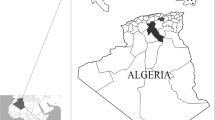Abstract
Ticks are hematophagous arthropods transmitting several harmful human and animal pathogens like viruses, Rickettsia, bacteria, and protozoa. The identification and speciation of ticks were normally performed in Iran using identification key of Arthur (1960) and Kaiser and Hoogstraal (J Parasitol 49:130–139, 1963) or on the basis of morphological characteristic keys recommended by Walker et al. (2003). Although these identification keys are well prepared, but there are in some cases due to the strong overlapping characteristics between species like Dermacentor marginatus and Dermacentor niveus accompanied with serious problems. D. marginatus and D. niveus have been intermittently used synonymously and there is no a generally agreement with the specification of these species. To find out more about these two species, we have analyzed the complete nucleotide sequence of ITS-2 region. Interestingly, we found indeed a sequence homology of 99% between nucleotide sequence of ITS-2 region of D. marginatus and D. niveus. Since the nucleotide sequence of ITS-2 region of D. marginatus in Iran has 98% sequence homology to the other in GenBank registered ITS-2 sequence of D. marginatus, and the morphological characteristics between both examined species showed minimal differences, therefore we believe that the D. marginatus and D. niveus could belong to the same species and 1% differences in nucleotide sequence of ITS-2 region between these two species can be understand as an intra-species polymorphism. The complete sequence of ITS-2 region of rRNA gene from D. marginatus and D. niveus registered under accession no. GQ144707 and GQ144706 by GenBank, respectively.




Similar content being viewed by others
References
Abbasian L (1961) Records of tick (Acarina:Ixodidae) occurring in Iran and their distributional data. Acarologia 3:546–59
Arthur DR (1960) A monograph of the ixodide. Pt v: Dermacentor, Anecentor, Comiomma, Boophilus and Margaropus. Cambridge University Press
Barker SC (1998) Distinguishing speciesand populations of Rhipicephaline ticks with ITS2 ribosomal RNA. J Parasitol 84(5):887–892
Brown SJ, Askenase PW (1986) Amblyomma americanum: physiochemical isolation of a parasite derived from the tick salivary gland that is capable of inducing immune resistance in guinea pigs. Exp Parasitol 62(1):40–50
Delpy L (1936) Note sur les Ixodides du genre Hyalomma (Koch). Annels de Parasitologie 14(3):206–45
Delpy L (1938) Les especes iranienes du genre Haemaphysalis Koch 1844. Annalles de Parasitologie Humaine et Comparee 16(1):1–10
Estrada-Pena A, Estrada-Pena R (1991) Notes on Dermacentor ticks: redescription of D. marginatus with the synonymies of D. niveus and D. daghestanicus (Acari:Ixodidae). J Med Entomol 28:2–12
Hoogstral H, Valdez R (1980) Ticks (Ixodoidea) from wild sheep and goats in Iran and medical and veterinary implications. Fieldiana Zool 6:1–16
Kaiser MN, Hoogstraal H (1963) The Hyalomma ticks (Ixodoidea, Ixodidae) of Afghanistan. J Parasitol 49:130–139
Mazlum Z (1971) Ticks of domestic animals in Iran: geographic distribution, host relation, and seasonal activity. J vet Fac, univ Tehran Iran 27(1):1–32
Nabian S, Rahbari S, Shayan P et al (2007) Current status of tick fauna in North of Iran. Iranian J Parasitol 2(1):12–17
Nabian S, Rahbari S, Shayan P et al (2008) Identification of tick species of Dermacentor in some localities of Iran. J Vet Res 63(1):87–90
Rahbari S (1995) Studies on some ecological aspects of tick fauna of West Azarbayejan, Iran. J Appl Anim Res 7:189–94
Rahbari S, Nabian S, Shayan P (2007) Primary report on distribution of tick fauna in Iran. Parasitol Res 101(2):175–177
Roman E, Sicrat M (1957) Les Dermacentor de France. Bull D’Hist Nat Toulouse 92:61–170
Sanger F, Niklen S, Coulson AR (1977) DNA sequencing with chain terminating inhibitors. Proc Natl Acad Sci 74:5463–5467
Shayan P, Hooshmand E, Rahbari S, Nabian S (2007) Determination of Rhipicephalus spp. as vectors for Babesia ovis in Iran. Parasitol Res 101(4):1029–1033
Shpynov S, Parolal P, Rudakov N, Samoilenko I, Takibaev M, Tarasevich I, Raoult D (2001) Detection and identification of Spotted Fever Group Rickettsiae in Dermacentor ticks from Russia and Central Kazakhstan. Eur J Clinical Microbiol Infect Dis 20:903–905
Telmadarraiy Z, Bahrami A, Vatandoost H (2004) A survey on fauna of ticks in West Azerbaijan Province, Iran. Iranian J Publ Health 33(4):65–69
Walker AR, Bouattour A, Camicas JL, Estrada-Pena A, Horak IG, Latif A, Pegram RG, Preston PM (2003) Ticks of domestic animals in Africa. A guide to identification of species. Bioscience Reports, Edinburgh
Wesson DM, McLain DK, Oliver JH, Piesman J, Collins FH (1993) Investigation of the validity of species status of Ixodes dammini(Acari:Ixodidae) using rDNA. Proc Natl Acad Sci U S A 90:10221–10225
Whitehouse CA (2004) Crimean Congo hemorrhagic fever. Antivir Res 64:145–160
Zahler M, Gothe R, Rinder H (1995) Genetic evidence against a morphologically suggestive conspecificity of dermacentor reticulates and D. marginatus (Acari:Ixodidae). Intern J Parasitol 25(12):1413–1419
Acknowledgement
We would like to thank the Iranian Ministry of Sciences, Research and Development for providing the financial support (Immunopathology Central Excellence grant) for this study and the Investigating group "Molecular Biological System Transfer" for technical support. We would like also to thank Nargess Amini for technical support.
Author information
Authors and Affiliations
Corresponding author
Rights and permissions
About this article
Cite this article
Moshaverinia, A., Shayan, P., Nabian, S. et al. Genetic evidence for conspecificity between Dermacentor marginatus and Dermacentor niveus . Parasitol Res 105, 1125–1132 (2009). https://doi.org/10.1007/s00436-009-1532-8
Received:
Accepted:
Published:
Issue Date:
DOI: https://doi.org/10.1007/s00436-009-1532-8




